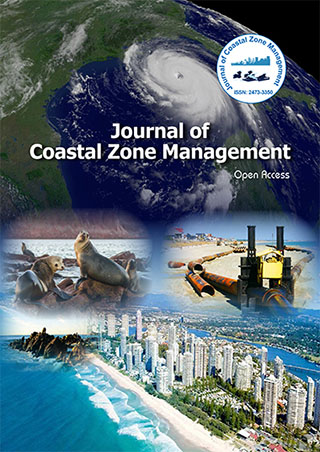Indexed In
- SafetyLit
- RefSeek
- Hamdard University
- EBSCO A-Z
- OCLC- WorldCat
- Publons
Useful Links
Share This Page
Journal Flyer

Open Access Journals
- Agri and Aquaculture
- Biochemistry
- Bioinformatics & Systems Biology
- Business & Management
- Chemistry
- Clinical Sciences
- Engineering
- Food & Nutrition
- General Science
- Genetics & Molecular Biology
- Immunology & Microbiology
- Medical Sciences
- Neuroscience & Psychology
- Nursing & Health Care
- Pharmaceutical Sciences
Perspective - (2024) Volume 27, Issue 6
Assessing the Role of Coral Reefs in Coastal Zone Protection and Biodiversity Conservation
Aser Veenex*Received: 28-Oct-2024, Manuscript No. JCZM-24-27585; Editor assigned: 30-Oct-2024, Pre QC No. JCZM-24-27585 (PQ); Reviewed: 15-Nov-2024, QC No. JCZM-24-27585; Revised: 22-Nov-2024, Manuscript No. JCZM-24-27585 (R); Published: 29-Nov-2024, DOI: 10.35248/2473-3350.24.27.657
Description
Coral reefs are some of the most diverse and valuable ecosystems on Earth, providing numerous ecological, economic and social benefits. In coastal areas, coral reefs lead a significant role in protecting shorelines from erosion and storm surges, acting as natural barriers against waves and currents. They also support vast biodiversity, serving as habitats for countless marine species. However, coral reefs face increasing threats from climate change, pollution and human activities, which jeopardize their ability to fulfill these roles. This article describes the importance of coral reefs in coastal protection and biodiversity conservation, as well as the challenges they face.
Coral reefs act as natural breakwaters, reducing wave energy and preventing shoreline erosion. Their complex structures slow down the movement of water, dissipating the force of waves before they reach the shore. This is especially important during storms and hurricanes, where coral reefs can absorb up to 97% of the wave energy, reducing the impact on coastal communities.
For countries with large coastal populations, such as those in Southeast Asia, the Caribbean and the Pacific, coral reefs are essential for minimizing damage from extreme weather events. By protecting coastlines from erosion and flooding, coral reefs help safeguard infrastructure, homes and livelihoods. The economic value of these protective services is immense, with some estimates suggesting that coral reefs save coastal communities billions of dollars in storm damage prevention each year.
Coral reefs are often referred to as the "rainforests of the sea" due to their incredible biodiversity. Despite covering less than 1% of the ocean floor, coral reefs support approximately 25% of all marine species. Fish, crustaceans, mollusks and other marine organisms rely on coral reefs for food, shelter and breeding grounds. This rich biodiversity not only contributes to the health of marine ecosystems but also supports local economies through fishing and tourism.
Unfortunately, coral reefs are among the most threatened ecosystems in the world. Climate change, in particular, poses a significant risk to coral reefs through the warming of ocean waters and ocean acidification. Warmer waters cause coral bleaching, a process in which corals expel the symbiotic algae living within their tissues. Without these algae, corals lose their vibrant colors and their primary food source, which can lead to mass die-offs if the stress persists.
Ocean acidification, driven by increased carbon dioxide absorption, reduces the ability of corals to produce their calcium carbonate skeletons. This weakens the reef structure and makes it more susceptible to damage from storms and human activities. Additionally, pollution, overfishing and coastal development further degrade coral reefs, diminishing their ability to protect coastlines and support marine life.
In response to the threats facing coral reefs, various conservation and restoration efforts have been implemented around the world. Marine Protected Areas (MPAs) have been established to restrict harmful human activities, such as overfishing and coastal development, in major coral reef regions. These protected areas help to maintain the ecological balance and give coral reefs a chance to recover from stressors.
Coral reefs are important for both coastal protection and biodiversity conservation, offering significant ecological and economic benefits. However, they face unprecedented challenges due to climate change, pollution and human activities. By strengthening conservation efforts and promoting restoration initiatives, we can work towards preserving these invaluable ecosystems for generations. Protecting coral reefs is not only a matter of safeguarding marine biodiversity but also a significant step in enhancing the resilience of coastal communities.
Citation: Veenex A (2024). Assessing the Role of Coral Reefs in Coastal Zone Protection and Biodiversity Conservation. J Coast Zone Manag. 27:657.
Copyright: © 2024 Veenex A. This is an open-access article distributed under the terms of the Creative Commons Attribution License, which permits unrestricted use, distribution, and reproduction in any medium, provided the original author and source are credited.
